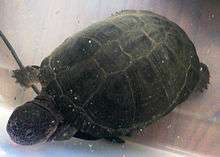West African mud turtle
| West African mud turtle | |
|---|---|
 | |
| Scientific classification | |
| Kingdom: | Animalia |
| Phylum: | Chordata |
| Subphylum: | Vertebrata |
| Class: | Reptilia |
| Order: | Testudines |
| Suborder: | Pleurodira |
| Family: | Pelomedusidae |
| Genus: | Pelusios |
| Species: | P. castaneus |
| Binomial name | |
| Pelusios castaneus[1][2] (Schweigger, 1812)[1][2] | |
| Synonyms[2] | |
| |
The West African mud turtle (West African side-necked turtle, swamp terrapin[3]) (Pelusios castaneus) is a species of turtle in the Pelomedusidae family. Pelusios castaneus is a freshwater species and is endemic to West and Central Africa.
Taxonomy

The so-called Seychelles black terrapin, Seychelles mud turtle, or Seychelles terrapin was considered a species of turtle (Pelusios seychellensis) in the Pelomedusidae family, endemic to Seychelles.[4]
Genetic analysis of the lectotype has shown, however, that this turtle was never a separate species, and is in fact Pelusios castaneus.[4] It is possible that specimens were confused in a private collection before being acquired by the Zoological Museum Hamburg in 1901, or else mislabeled there.[5]
Distribution
The West African mud turtle is found in the following countries of West and Central Africa: Angola, Benin, Burkina Faso, Cameroon, Cape Verde, Democratic Republic of the Congo, Republic of the Congo, Equatorial Guinea, Gabon, Ghana, Guinea, Guinea-Bissau, Ivory Coast, Liberia, Mali, Príncipe, Senegal, Sierra Leone, Togo. Additionally, it has been introduced to Guadeloupe.[1]
Ecology
The West African mud turtle is carnivorous and feeds on aquatic prey. There are five phases to feeding; preliminary head fixation on the prey, fine-tuning the head fixation, final approach by the head, grasping of the prey followed by manipulation and transportation, and suction, resulting in ingestion after which the prey is swallowed. The final phase varies according to whether the prey is fast-moving, like a fish, or slow-moving like a gastropod mollusc.[6]
References
- 1 2 3 4 Rhodin 2011, p. 000.215
- 1 2 3 Fritz 2007, pp. 346-347
- ↑ Broadley, Donald G. (1973). "Provisional List of Vernacular Names for Rhodesian Reptiles and Amphibians". The Journal of the Herpetological Association of Africa. 10 (1): 17–24. doi:10.1080/04416651.1973.9650652.
- 1 2 "One Extinct Turtle Less: Turtle Species in the Seychelles Never Existed". Science Daily. Retrieved April 4, 2013.
- ↑ Stuckas, Heiko; Gemel, Richard; Fritz, Uwe; Canestrelli, Daniele (April 3, 2013). "One Extinct Turtle Species Less: Pelusios seychellensis Is Not Extinct, It Never Existed". PLoS ONE. 8 (4): e57116. PMC 3616038
 . PMID 23573185. doi:10.1371/journal.pone.0057116. Retrieved April 4, 2013.
. PMID 23573185. doi:10.1371/journal.pone.0057116. Retrieved April 4, 2013. - ↑ Lemell, P.; Weisgram, J. (1996). "Feeding Patterns of Pelusios castaneus (Chelonia: Pleurodira)". Netherlands Journal of Zoology. 47 (4): 429–. doi:10.1163/156854297X00102.
Bibliography
- Rhodin, Anders G.J.; van Dijk, Peter Paul; Inverson, John B.; Shaffer, H. Bradley; Roger, Bour (2011-12-31). "Turtles of the world, 2011 update: Annotated checklist of taxonomy, synonymy, distribution and conservation status". Chelonian Research Monographs. 6. Archived from the original (PDF) on 2012-01-22.
- Fritz, Uwe; Havaš, Peter (2007-10-31). "Checklist of Chelonians of the World". Archived from the original (pdf) on 2010-12-29. Retrieved 2010-12-29.
External links
| Wikispecies has information related to: Pelusios castaneus |
